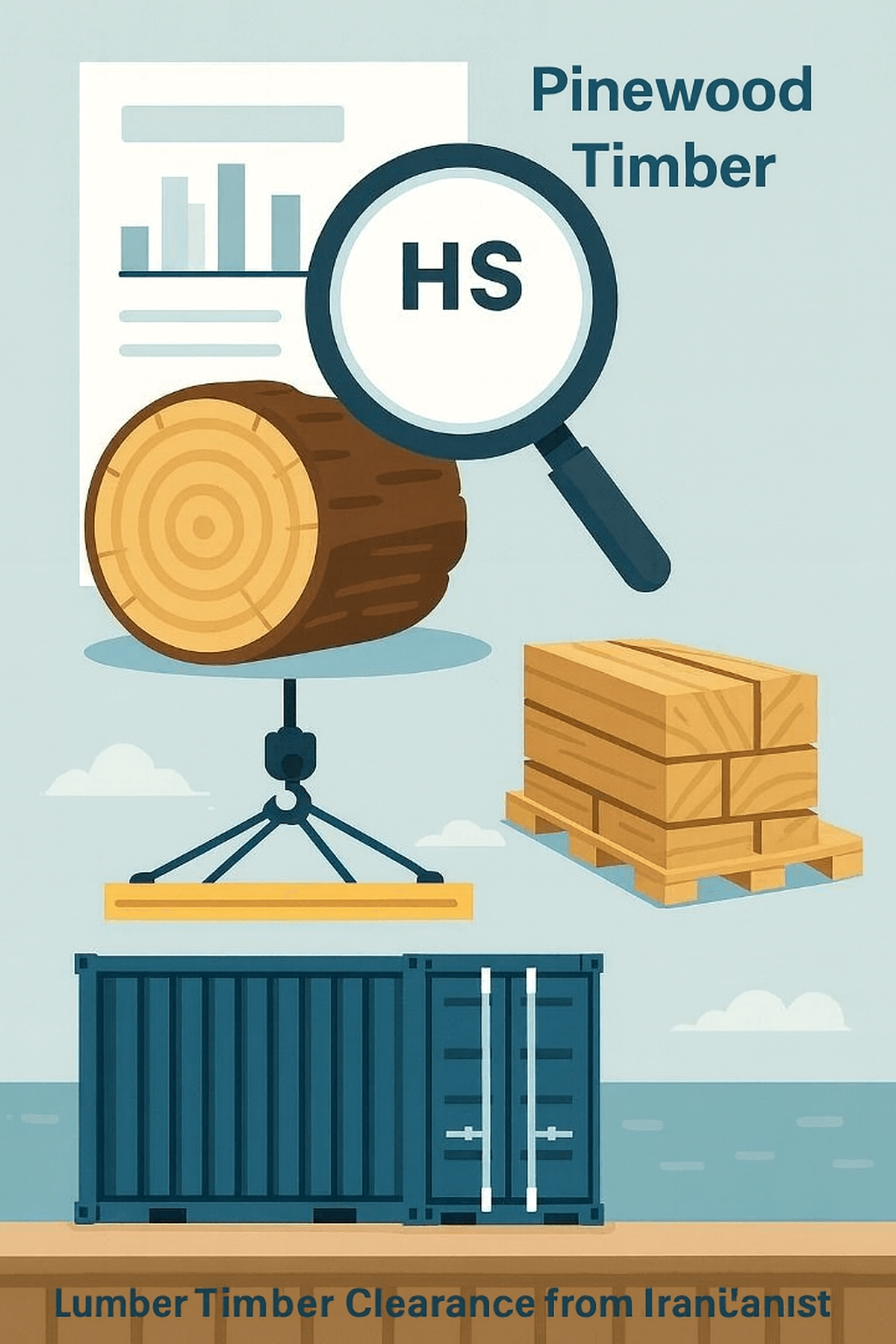Customs Clearance of Pine Wood in Iran (HS Code + Documents and Permits)
To estimate the time and cost of clearing pine wood (Pine Wood), contact the experts at Saba Tarkhis.
Immediate & Free Consultation
1) Applications of Pine Wood in Various Industries
Furniture industry: Because of medium density and high flexibility, pine wood is an ideal option for producing furniture and wooden artifacts. It is easy to paint and finish, and it is highly resistant to temperature and humidity changes. Its lightness also makes it popular for modern, lightweight furniture.
Construction industry: Thanks to its strength and suitable resistance to weather and environmental conditions, pine wood is a popular choice for wooden frames, wooden roofs, and building railings. In addition to an attractive appearance, it has high mechanical performance, making it suitable for wooden structures.
Paper and cardboard production: The long fibers of pine wood make it an ideal material for producing various papers. It is particularly used for thicker papers and packaging paper due to its durability and high quality.
Packaging industries: Owing to a favorable price, pine is widely used for transport pallets and industrial packing crates. Besides being economical, its impact and pressure resistance makes it popular in logistics.
2) Customs Tariff and Technical Notes in Clearing Pine Wood
| Product | Short Description | HS Code |
|---|---|---|
| Raw pine wood | Unprocessed logs/timber | 4403 |
| Processed pine wood | Sawn/boards/planed | 4407 |
Exact classification depends on species, moisture grade, dimensions, processing level, treatment (kiln/phyto-sanitation), and supplier documentation.
3) Conditions for Importing and Exporting Pine Wood to Iran
Countries Exporting Pine Wood to Iran
Countries Importing Pine Wood from Iran
Import and Export Volumes of Pine Wood to Iran
Global Financial Turnover of Pine Wood
Countries Importing Pine Wood Worldwide
4) Sanitary and Quarantine Regulations
5) Documents Required for Clearing Pine Wood
1. Certificate of Origin
Specifies the exporting country and is issued by official authorities in the origin country. It is essential for determining customs tariffs and import duties.
2. Commercial Invoice
Includes details of value, quantity, and exact specifications of the shipment. It is needed to determine customs tariffs and other costs.
3. Packing List
Provides information on packing method, number of packages, net and gross weight of each package, helping customs to inspect and verify packages properly.
4. Bill of Lading
Shows the movement from origin to destination and is issued by the carrier. It proves ownership and is necessary for final clearance.
5. Phytosanitary Certificate
Confirms the imported pine is free from plant pests or diseases. Issued by agricultural/environmental authorities in the origin country and is mandatory in many jurisdictions.
6. Customs Declaration
Contains details on type, value, and tariffs of the imported goods. Submitted by the importer and must comply with destination regulations.
7. Standard Certificate
In some cases, wood imports require conformity approvals showing compliance with technical and quality standards of the destination country.
8. Import License
Some countries require a government-issued import license to ensure environmental and trade compliance.
9. Inspection Certificate
In certain cases, a technical inspection is required before clearance. This confirms compliance with destination standards and readiness for clearance.
10. Environmental Permit
For pine imports, special environmental permits may be required to ensure no environmental harm and full compliance with regulations.
11. Forestry Compliance Certificate (FSC Certification)
In many countries, forest management certifications such as FSC are required to ensure sustainable sourcing from well-managed forests.
12. Release Order
Finally, after all documents are approved and fees paid, customs issues the release order allowing the importer to take the goods to market.
Need precise HS Code determination, phytosanitary certifications, and document preparation? Our team manages the entire case end to end.
Submit Proforma RequestFrequently Asked Questions
What is the HS Code for raw pine wood?
Per your text, raw wood is commonly declared under 4403; final determination depends on species, dimensions, and treatment.
Which HS Code applies to processed pine wood?
Items that are sawn/board/planed generally fall under 4407; technical details and supplier documents affect the exact subheading.
What documents are required for clearance?
Certificate of Origin, Commercial Invoice, Packing List, Bill of Lading, Phytosanitary Certificate, Customs Declaration, Standard Certificate, Import License, Inspection Certificate, and finally the Release Order.
Special Customs-Clearance Services by Saba Brokerage
Relying on a team of professional customs experts, we provide a wide range of services that help importers and exporters complete clearance efficiently and quickly.
Specialized consulting: Our experts review customs regulations, suitable tariff codes, and sanitary/quarantine requirements to offer practical solutions for import/export. This includes a full analysis of laws and standards in origin and destination countries to prevent potential issues.
Full follow-up of customs stages: With extensive experience in preparing and submitting documents, our team follows all customs stages from start to finish. Leveraging strong relations with customs authorities, we prevent unnecessary delays and ensure a smooth process.
Expediting clearance: Thanks to expertise and broad cooperation networks, clearance is completed in the shortest possible time and at reasonable cost, ensuring administrative steps proceed swiftly and without problems.
Resolving legal obstacles: If any legal hurdles arise, our experienced specialists resolve them quickly to avoid extra delays or unforeseen costs.
With these services, importers and exporters of pine wood can confidently entrust clearance to a reputable company and benefit from a fast, accurate, and cost-effective experience.
.png)
